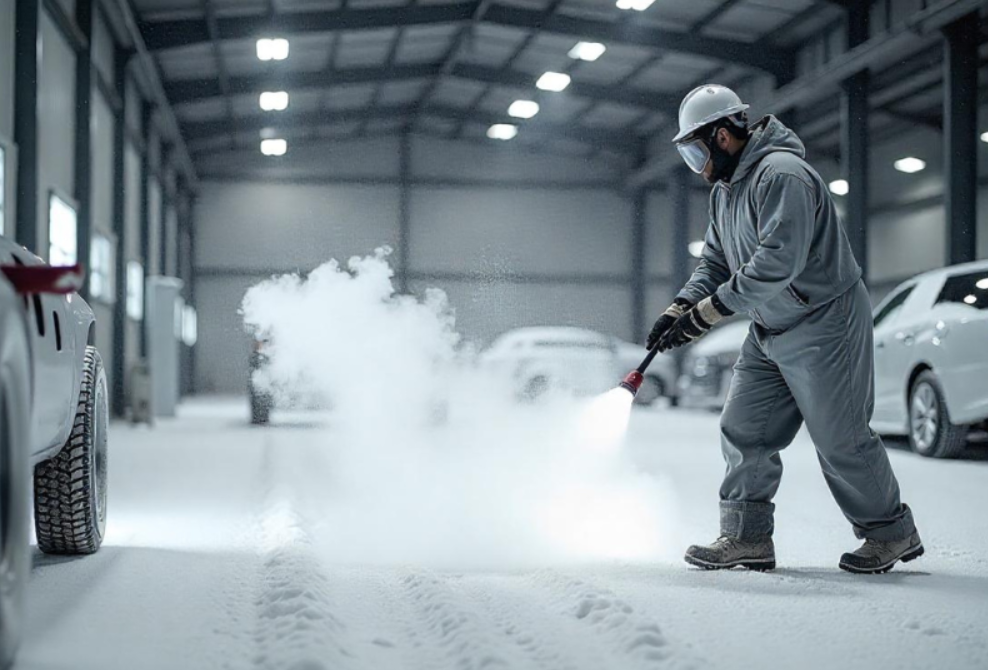What Is Dry Ice Blasting?
Dry ice blasting, also known as CO₂ cleaning, is an industrial cleaning process that utilizes compressed air and dry ice pellets (solid carbon dioxide) as a cleaning medium. Unlike traditional abrasive methods, dry ice blasting is non-abrasive, non-conductive, non-toxic, and leaves no secondary waste. It removes contaminants through thermal shock and kinetic energy, making it ideal for delicate or hard-to-reach surfaces.
How Dry Ice Blasting Works
Dry ice pellets are propelled at high velocity using compressed air. Upon impact, the dry ice rapidly sublimates (converts directly from solid to gas), causing micro-explosions that lift contaminants without damaging the underlying surface. The combined effects of thermal shock, impact force, and gas expansion result in efficient and residue-free cleaning.
Benefits of Dry Ice Blasting
1. Environmentally Friendly
Dry ice blasting uses recycled CO₂, making it a sustainable option. It produces no secondary waste, reduces the need for harmful chemicals, and complies with EPA and FDA regulations.
2. No Equipment Damage
Since dry ice is non-abrasive, it won’t etch, warp, or degrade delicate surfaces like electrical components, molds, or polished metals. This makes it suitable for cleaning sensitive equipment without disassembly.
3. Minimizes Downtime
Unlike traditional cleaning methods that require equipment shutdown and labor-intensive prep, dry ice blasting allows for in-place cleaning (online cleaning), reducing operational downtimes significantly.
4. Sanitization and Sterilization
Dry ice blasting eliminates bacteria, mold, and biofilms, making it highly effective in food processing, pharmaceutical, and medical device environments where sterility is paramount.
Key Applications of Dry Ice Blasting
1. Industrial Equipment Cleaning
From printing presses to power generators, dry ice blasting removes grease, oil, adhesives, and soot without harming machinery. It reaches tight spaces and complex geometries without needing disassembly.
2. Mold Remediation
Dry ice blasting is highly effective at removing mold spores from wood, concrete, and brick. It sanitizes affected areas without adding moisture, which helps prevent future infestations.
3. Fire and Smoke Restoration
This method safely removes soot, char, and smoke damage from surfaces including brick, metal, and wood. It restores property quickly with minimal residue and odor.
4. Automotive and Aerospace
In automotive restoration, it cleans engines, transmissions, and undercarriages. In aerospace, it’s used for aerospace part cleaning where precision and zero-abrasion are vital.
5. Food and Beverage Industry
Dry ice blasting cleans ovens, conveyors, mixers, and packaging lines without water or chemicals. It’s compliant with FDA, USDA, and EPA standards, ensuring safe food production environments.
Types of Dry Ice Blasting Systems
1. Single-Hose Systems
The more modern and commonly used system, single-hose configurations offer consistent pellet flow, greater blasting control, and are compatible with automated systems.
2. Dual-Hose Systems
These use two hoses to deliver compressed air and dry ice separately. While cost-effective, they deliver lower velocity and are less efficient in industrial-scale cleaning.
3. MicroParticle Systems
These systems use finely ground dry ice particles and are ideal for delicate electronics, circuit boards, and cleanrooms.
How to Choose the Right Dry Ice Blasting Equipment
When selecting a system, consider:
-
Cleaning Surface Type: Smooth vs porous, sensitive vs industrial.
-
Contaminant Nature: Grease, soot, rust, adhesives, etc.
-
Required Cleaning Speed and Scale
-
Mobility Requirements
-
Noise and Safety Regulations
Professional dry ice blasting companies offer customized solutions, including portable units, automated nozzles, and robotic integration for large-scale operations.
Dry Ice Blasting vs Other Cleaning Methods
| Method | Abrasive | Chemical Use | Waste Produced | Surface Safety | Downtime |
|---|---|---|---|---|---|
| Dry Ice Blasting | No | No | None | Excellent | Low |
| Sandblasting | Yes | No | High | Poor | High |
| Pressure Washing | No | Often Yes | Water Waste | Moderate | Moderate |
| Chemical Cleaning | No | Yes | Chemical Waste | Variable | High |
Dry ice blasting stands out for surface preservation, eco-friendliness, and speed.
Safety Considerations in Dry Ice Blasting
While dry ice blasting is safer than many traditional methods, it’s crucial to follow safety protocols:
-
Ventilation: Ensure adequate airflow to avoid CO₂ buildup.
-
PPE Use: Operators should wear eye protection, hearing protection, and insulated gloves.
-
Training: Only trained personnel should handle the equipment to avoid frostbite or improper usage.
Cost of Dry Ice Blasting Services
The cost of dry ice blasting depends on several factors:
-
Size of the Area: Larger areas increase cost.
-
Type of Contaminants: Tougher residues may require more time.
-
Surface Sensitivity: Delicate equipment requires more precision and lower blasting pressures.
-
Location & Accessibility: Travel, equipment transport, and labor contribute to total cost.
Typical commercial rates range from $300 to $1,000 per hour, inclusive of labor, equipment, and materials. However, considering reduced downtime, less maintenance, and no post-cleaning cleanup, many clients report net savings over traditional methods.
How to Prepare for a Dry Ice Blasting Service
-
Identify Cleaning Goals: Define what needs to be removed and from where.
-
Evaluate Site Conditions: Ensure accessible space and good ventilation.
-
Remove Loose Debris: Clear away items that don’t require cleaning.
-
Communicate with Service Provider: Share equipment manuals, cleaning restrictions, and safety protocols.
Why Choose Professional Dry Ice Blasting Services
A reputable provider brings certified technicians, advanced blasting machines, and customized solutions for your specific industry. From in-depth assessments to post-cleaning inspections, professionals ensure your facility meets operational, regulatory, and environmental standards.


